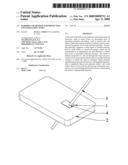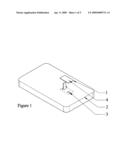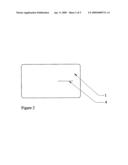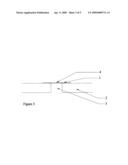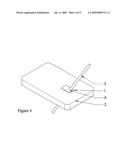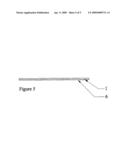Patent application title: BARRIER AND METHOD FOR PROTECTING ENCLOSED STRUCTURES
Inventors:
Jason L. Soldini (Fort Lauderdale, FL, US)
IPC8 Class: AB65D2500FI
USPC Class:
220730
Class name: Receptacles container attachment or adjunct protective guard (e.g., animal deterrent)
Publication date: 2009-04-09
Patent application number: 20090090731
and method for protecting enclosed structures,
such as utility boxes, by preventing entry of unwanted materials and
objects, such as insects, dirt, and debris, while allowing the insertion
of objects used for opening and closing the cover of the enclosed
structure. The barrier generally comprises a sheet made of suitable
material, such as solid rubber or closed-cell sponge, which can be
manipulated to an appropriate size and attached to a utility box cover,
or equivalent enclosed structure. The barrier is further comprised of a
slit cut through the sheet and positioned over an access hole located on
the cover of the enclosed structure to which the sheet is attached. When
properly attached and positioned, the barrier is substantially
impermeable to undesired objects and materials while a slit in the
barrier allows a tool used for opening and closing the structure's cover
to pass through the barrier without compromising the barrier's
impermeable character.Claims:
1. A barrier comprising a sheet attached to the cover of an enclosed
structure; said sheet being substantially impermeable to undesired
objects or materials; said sheet further comprising a slit of sufficient
length to allow passage of an object through said slit whereby said
object can ingress into and egress from said enclosed structure.
2. The barrier of claim 1 wherein said enclosed structure is a utility box.
3. The barrier of claim 2 wherein said utility box is a water meter.
4. The barrier of claim 1 wherein said sheet is comprised of rubber.
5. The barrier of claim 1 wherein said sheet is comprised of closed-cell sponge.
6. The barrier of claim 1 wherein said object is a tool used for opening and closing said cover of said enclosed structure.
7. The barrier of claim 1 wherein said sheet is impermeable to insects.
8. The barrier of claim 7 wherein said insects are bees.
9. A method of preventing the ingress of undesired objects or materials into an enclosed structure, and allowing the ingress and egress of an object used for opening and closing a cover to said enclosed structure, comprised of the following steps: Attaching a sheet that is substantially impermeable to undesired objects or materials to said cover of said enclosed structure; providing a slit on said sheet of sufficient length to allow passage of said object through said slit whereby said object can ingress into and egress from said enclosed structure.
10. The method of claim 9 wherein said enclosed structure is a utility box.
11. The method of claim 10 wherein said utility box is a water meter.
12. The method of claim 9 wherein said sheet is comprised of rubber.
13. The method of claim 9 wherein said sheet is comprised of closed-cell sponge.
14. The method of claim 9 wherein said object is a tool used for opening and closing said cover of said enclosed structure.
15. The method of claim 9 wherein said sheet is impermeable to insects.
16. The method of claim 15 wherein said insects are bees.Description:
CROSS REFERENCE TO RELATED APPLICATIONS
[0001]This application claims the benefit under 35 U.S.C. §119(e) of U.S. Provisional Application No. 60/997,378, filed on Oct. 3, 2007, the complete disclosure of which is incorporated herein by reference in its entirety.
FIELD OF THE INVENTION
[0002]The present invention relates to an accessible barrier and method for preventing entry of unwanted materials and objects into an enclosed structure, such as a utility box, while allowing the ingress and egress of an object used for opening and closing the cover of the enclosed structure.
BACKGROUND OF THE INVENTION
[0003]Typically, a utility box is set in the ground with the cover of the utility box situated at ground level. For many utility boxes, when access is necessary, the cover is opened by insertion of a tool through an access hole provided in the utility box's cover. Once the tool is inserted into the utility box, the utility box cover can then be pried open with the assistance of the tool.
[0004]This access hole may also facilitate the entry of undesirable objects and materials such as insects, dirt, and debris. While barricading the access hole may prevent the entry of these undesired objects and materials, it will also interfere with the ability to insert a tool into the access hole, and thereby, negatively affect efforts to open the utility box cover.
[0005]It is therefore an object of the present invention to provide a new and useful barrier that can be attached to the utility box cover in order to effectively prevent the entry of undesired materials and objects, such as insects, dirt, and debris, through the utility box cover's access hole.
[0006]It is a further object of the present invention to provide a new and useful barrier that allows the entry of a tool for opening the utility box cover.
[0007]In a preferred embodiment of the present invention, the barrier is attached directly on the inside or outside of the utility box cover. It is also preferred that the barrier further comprises a slit that allows entry of a tool for opening the utility box cover. It is also preferred that the slit is positioned directly over the utility box cover's access hole.
[0008]In a preferred embodiment of the present invention, the barrier is comprised of a sheet made of a variety of materials that can be easily manipulated for compatibility with a variety of utility box covers and their corresponding access holes.
BRIEF DESCRIPTION OF THE DRAWINGS
[0009]FIG. 1 is a top view of the barrier.
[0010]FIG. 2 is the vertical cross section of the barrier.
[0011]FIG. 3 is a cross sectional view of the barrier attached to the utility box cover.
[0012]FIG. 4 is a perspective view of a tool as it is inserted through the attached barrier and the utility box cover.
[0013]FIG. 5 is a horizontal cross section of the barrier.
DETAILED DESCRIPTION
[0014]The present invention provides a new and useful barrier and method that prevents the entry of unwanted materials and objects into an enclosed structure, such as a utility box, while allowing the ingress and egress of devices used for opening and closing the cover of such enclosed structures.
[0015]As depicted in FIGS. 1-5, in a preferred embodiment of the present invention, the barrier comprises a sheet 1, preferably made of rubber, neoprene, light-weight plastic, fabric-coated closed-cell sponge or any suitable equivalent thereof. Preferably, the sheet should be durable enough to withstand the effects of outdoor environments. Preferably, the sheet should be substantially impermeable to undesired objects and materials, such as insects, dirt, debris that may otherwise enter a utility box via the utility box cover's access hole. Preferably, the sheet can be easily manipulated for universal application of the sheet on any shape, style, or variety of utility box cover.
[0016]As depicted in FIG. 1, in a preferred embodiment of the present invention, the sheet 1 has a sufficient length and width to allow attachment of the sheet to the utility box cover 2 when the sheet 1 is placed over the utility box cover's access hole 3.
[0017]As depicted in FIGS. 1 and 2, in a preferred embodiment of the present invention, the sheet 1 further comprises a slit 4. As depicted in FIG. 4, the slit 4 should preferably be of a sufficient length to permit the passage of any acceptable tool 5 used for opening and closing utility box covers. In another embodiment of the present invention, the length of slit 4 can be manipulated to permit the passage of any variety of objects, including but not limited to a human hand or finger that may be utilized to open and close the cover of an enclosed structure, such as a utility box.
[0018]As depicted in FIG. 4, the slit allows the tool 5 to ingress into and egress out of the utility box. Preferably, as depicted in FIG. 2, when the tool 5 is not interacting with the slit 4, the impermeable character of the sheet 1 should not be compromised by the slit 4.
[0019]As depicted in FIGS. 3 and 4, in a preferred embodiment of the present invention, the sheet 1 is attached to the top of the utility box cover 2, i.e., the side of the utility box cover facing away from the utility box, and positioned on the utility box cover so that the slit 4 is located directly above the access hole 3. In another embodiment of the present invention, the sheet 1 is attached to the bottom of the utility box cover 2, i.e., the side of the utility box cover facing into the utility box cover, and positioned on the utility box cover so that slit 4 is located directly below the access hole 3.
[0020]The sheet 1 can be attached to the utility box cover 2 using any suitable means, including but not limited to adhering the sheet to the utility box cover, screwing the sheet to the utility box cover, nailing the sheet to the utility box cover, strapping the sheet to the utility box cover, or using any other suitable equivalent attaching means.
[0021]As depicted in FIG. 5, in a preferred embodiment of the present invention, the sheet 1 is further comprised of coat of adhesive 6 applied to one side of the sheet. Preferably, the side of the sheet 1 coated with the adhesive 6 contacts the surface of the utility box cover 2. The adhesive 6 can be made of any acceptable material strong enough to bond the sheet 1 to the utility box cover 2 in such a manner that the sheet 1 will not detach from the utility box cover 2 when the tool 5, or an equivalent thereof, interacts with the slit 4. Preferably, the adhesive 6 should also be durable enough to withstand the effects of outdoor environments. In yet another embodiment of the present invention the adhesive 6 can be covered with a non-stick surface that can be removed from or peeled away from the adhesive 6 prior to attaching the sheet to the utility box cover.
[0022]While the barrier device has been described above in connection with a utility box cover, it will be apparent to persons skilled in the art that the invention can be used to form a barrier in any application where an access hole to an enclosed structure requires a barrier to prevent the ingress of undesired materials or objects. It will of course be realized that while the foregoing has been given by way of illustrative example of this invention, all, such and other modifications and variations thereto as would be apparent to persons skilled in the art are deemed to fall within the scope and ambit of this invention as is herein described.
Claims:
1. A barrier comprising a sheet attached to the cover of an enclosed
structure; said sheet being substantially impermeable to undesired
objects or materials; said sheet further comprising a slit of sufficient
length to allow passage of an object through said slit whereby said
object can ingress into and egress from said enclosed structure.
2. The barrier of claim 1 wherein said enclosed structure is a utility box.
3. The barrier of claim 2 wherein said utility box is a water meter.
4. The barrier of claim 1 wherein said sheet is comprised of rubber.
5. The barrier of claim 1 wherein said sheet is comprised of closed-cell sponge.
6. The barrier of claim 1 wherein said object is a tool used for opening and closing said cover of said enclosed structure.
7. The barrier of claim 1 wherein said sheet is impermeable to insects.
8. The barrier of claim 7 wherein said insects are bees.
9. A method of preventing the ingress of undesired objects or materials into an enclosed structure, and allowing the ingress and egress of an object used for opening and closing a cover to said enclosed structure, comprised of the following steps: Attaching a sheet that is substantially impermeable to undesired objects or materials to said cover of said enclosed structure; providing a slit on said sheet of sufficient length to allow passage of said object through said slit whereby said object can ingress into and egress from said enclosed structure.
10. The method of claim 9 wherein said enclosed structure is a utility box.
11. The method of claim 10 wherein said utility box is a water meter.
12. The method of claim 9 wherein said sheet is comprised of rubber.
13. The method of claim 9 wherein said sheet is comprised of closed-cell sponge.
14. The method of claim 9 wherein said object is a tool used for opening and closing said cover of said enclosed structure.
15. The method of claim 9 wherein said sheet is impermeable to insects.
16. The method of claim 15 wherein said insects are bees.
Description:
CROSS REFERENCE TO RELATED APPLICATIONS
[0001]This application claims the benefit under 35 U.S.C. §119(e) of U.S. Provisional Application No. 60/997,378, filed on Oct. 3, 2007, the complete disclosure of which is incorporated herein by reference in its entirety.
FIELD OF THE INVENTION
[0002]The present invention relates to an accessible barrier and method for preventing entry of unwanted materials and objects into an enclosed structure, such as a utility box, while allowing the ingress and egress of an object used for opening and closing the cover of the enclosed structure.
BACKGROUND OF THE INVENTION
[0003]Typically, a utility box is set in the ground with the cover of the utility box situated at ground level. For many utility boxes, when access is necessary, the cover is opened by insertion of a tool through an access hole provided in the utility box's cover. Once the tool is inserted into the utility box, the utility box cover can then be pried open with the assistance of the tool.
[0004]This access hole may also facilitate the entry of undesirable objects and materials such as insects, dirt, and debris. While barricading the access hole may prevent the entry of these undesired objects and materials, it will also interfere with the ability to insert a tool into the access hole, and thereby, negatively affect efforts to open the utility box cover.
[0005]It is therefore an object of the present invention to provide a new and useful barrier that can be attached to the utility box cover in order to effectively prevent the entry of undesired materials and objects, such as insects, dirt, and debris, through the utility box cover's access hole.
[0006]It is a further object of the present invention to provide a new and useful barrier that allows the entry of a tool for opening the utility box cover.
[0007]In a preferred embodiment of the present invention, the barrier is attached directly on the inside or outside of the utility box cover. It is also preferred that the barrier further comprises a slit that allows entry of a tool for opening the utility box cover. It is also preferred that the slit is positioned directly over the utility box cover's access hole.
[0008]In a preferred embodiment of the present invention, the barrier is comprised of a sheet made of a variety of materials that can be easily manipulated for compatibility with a variety of utility box covers and their corresponding access holes.
BRIEF DESCRIPTION OF THE DRAWINGS
[0009]FIG. 1 is a top view of the barrier.
[0010]FIG. 2 is the vertical cross section of the barrier.
[0011]FIG. 3 is a cross sectional view of the barrier attached to the utility box cover.
[0012]FIG. 4 is a perspective view of a tool as it is inserted through the attached barrier and the utility box cover.
[0013]FIG. 5 is a horizontal cross section of the barrier.
DETAILED DESCRIPTION
[0014]The present invention provides a new and useful barrier and method that prevents the entry of unwanted materials and objects into an enclosed structure, such as a utility box, while allowing the ingress and egress of devices used for opening and closing the cover of such enclosed structures.
[0015]As depicted in FIGS. 1-5, in a preferred embodiment of the present invention, the barrier comprises a sheet 1, preferably made of rubber, neoprene, light-weight plastic, fabric-coated closed-cell sponge or any suitable equivalent thereof. Preferably, the sheet should be durable enough to withstand the effects of outdoor environments. Preferably, the sheet should be substantially impermeable to undesired objects and materials, such as insects, dirt, debris that may otherwise enter a utility box via the utility box cover's access hole. Preferably, the sheet can be easily manipulated for universal application of the sheet on any shape, style, or variety of utility box cover.
[0016]As depicted in FIG. 1, in a preferred embodiment of the present invention, the sheet 1 has a sufficient length and width to allow attachment of the sheet to the utility box cover 2 when the sheet 1 is placed over the utility box cover's access hole 3.
[0017]As depicted in FIGS. 1 and 2, in a preferred embodiment of the present invention, the sheet 1 further comprises a slit 4. As depicted in FIG. 4, the slit 4 should preferably be of a sufficient length to permit the passage of any acceptable tool 5 used for opening and closing utility box covers. In another embodiment of the present invention, the length of slit 4 can be manipulated to permit the passage of any variety of objects, including but not limited to a human hand or finger that may be utilized to open and close the cover of an enclosed structure, such as a utility box.
[0018]As depicted in FIG. 4, the slit allows the tool 5 to ingress into and egress out of the utility box. Preferably, as depicted in FIG. 2, when the tool 5 is not interacting with the slit 4, the impermeable character of the sheet 1 should not be compromised by the slit 4.
[0019]As depicted in FIGS. 3 and 4, in a preferred embodiment of the present invention, the sheet 1 is attached to the top of the utility box cover 2, i.e., the side of the utility box cover facing away from the utility box, and positioned on the utility box cover so that the slit 4 is located directly above the access hole 3. In another embodiment of the present invention, the sheet 1 is attached to the bottom of the utility box cover 2, i.e., the side of the utility box cover facing into the utility box cover, and positioned on the utility box cover so that slit 4 is located directly below the access hole 3.
[0020]The sheet 1 can be attached to the utility box cover 2 using any suitable means, including but not limited to adhering the sheet to the utility box cover, screwing the sheet to the utility box cover, nailing the sheet to the utility box cover, strapping the sheet to the utility box cover, or using any other suitable equivalent attaching means.
[0021]As depicted in FIG. 5, in a preferred embodiment of the present invention, the sheet 1 is further comprised of coat of adhesive 6 applied to one side of the sheet. Preferably, the side of the sheet 1 coated with the adhesive 6 contacts the surface of the utility box cover 2. The adhesive 6 can be made of any acceptable material strong enough to bond the sheet 1 to the utility box cover 2 in such a manner that the sheet 1 will not detach from the utility box cover 2 when the tool 5, or an equivalent thereof, interacts with the slit 4. Preferably, the adhesive 6 should also be durable enough to withstand the effects of outdoor environments. In yet another embodiment of the present invention the adhesive 6 can be covered with a non-stick surface that can be removed from or peeled away from the adhesive 6 prior to attaching the sheet to the utility box cover.
[0022]While the barrier device has been described above in connection with a utility box cover, it will be apparent to persons skilled in the art that the invention can be used to form a barrier in any application where an access hole to an enclosed structure requires a barrier to prevent the ingress of undesired materials or objects. It will of course be realized that while the foregoing has been given by way of illustrative example of this invention, all, such and other modifications and variations thereto as would be apparent to persons skilled in the art are deemed to fall within the scope and ambit of this invention as is herein described.
User Contributions:
Comment about this patent or add new information about this topic:

